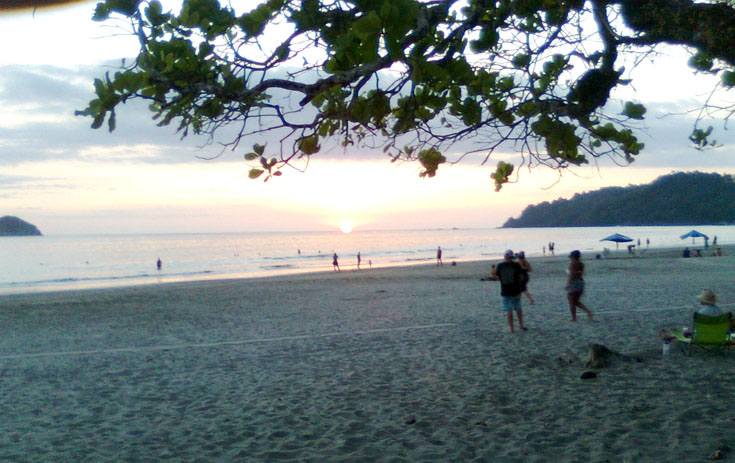|
|---|
Admiring Another Sunset at Manuel Antonio Beach (Playa Espadilla) |
Broken News
Rainforest on Fire
When people think of the rainforest, tumultuous tropical rains come to mind.
But this is"verano", the summer or dry season that roughly spans Dec 15 to May 15, and it can get very dry in Costa Rica in verano. This year seems to be particularly bad, some say it's the worst in over 10 years. It certainly is the driest so far in the eight years our hero has been visiting and living here.
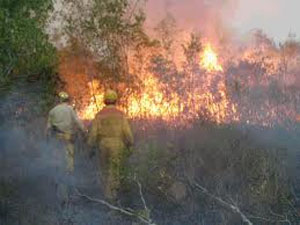 |
|---|
A Recent Mountain Fire Near Chíripo |
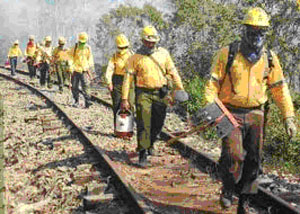 |
Costa Rican Bomberos (Firefighters) on Their Way to Another Forest Fire |
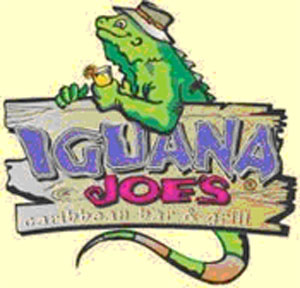 |
Costa Rica's Answer to Smoky the Bear What, Me Worry (hic)? |
On a recent short jaunt up the coast to Jacó (40 miles), we passed at least four patches of burned out grass that seemed to be the results of flash brush fires. The patches were of such a size and position to suggest they were random and not a part of a planned burn scheme that's sometimes used as a tactic in the U.S. Most of them also were close to the highway suggesting a carelessly tossed cigarette might have been the cause.
(I'm told smokers are the second major cause for blame after George Bush for anything that goes bad ).
Dry lightening of course is another cause of forest and brush fires , particular in more rural, mountainous areas. The Cuerpo de Bomberos, the national firefighters organization stated in early March that there had been 63 blazes in wooded areas. And several of these were major fires that have destroyed at least 3,000 acres of forested land.
A fire at the tallest mountain in Costa Rica (Chírripó - in south-central Costa Rica - 3,820 meters/12,600 feet), was contained only after several exhausting days fighting it. At this writing in mid-March, another fire was marching down a mountain south of San Isidro in southern Costa Rica towards the Panamanian border. Unlike the Nicas on our northern border, we intend no invasion of our Panamanian amigos.
A late report from the Chírripó fire stated that officials had discovered that some 600 marijuana plants also had been consumed by the fire. Neighbors on a nearby hill made no complaints about the smoke wafting its way towards them but instead were reported to have an unexplained quizzical grin on their faces. ¡Pura Vida!
And it's not just the land that's a bit parched. Two large boats in Puntarenas caught fire recently from a welding torch. There have also been fires at a number of vacant lots in San José where clouds of smoke have bathed the downtown area. (It brings to mind the marsh blazes we had in west central Florida at this time of year that could literally obliterate vision on I-75 causing many accidents).
So, despite being as green as we usually are here, we are not totally impervious to the ravages of forest and brush fires. One needs to take the same precautions here at this time of year as is done in dry climates in other parts of the world. At least until we start complaining about the rain in a few months.
Stay kool, stay dry, naw, stay wet, amigos.
Bulletin-Late Update: On the evening of March 21, more than two months after the previous rain, the skies broke over Quepos/Manuel Antonio and delivered a medium-strong rain for a few hours. I never thought I'd be saying it but it was good to see puddles in the street again. The following day GG had to make a day trip to San José and on the return we encountered strong rains from Orotina to Parrita, a distance of about 100 kilometers (60 miles). The drought has been broken, at least for the moment - ¡Ojalá que lo continué! (Let's hope it continues).
Two editions ago we reported (again, note the judicial use of the royal we) on a new corporate tax being instituted by the current Costa Rican administration (see New Tax). But there are many aspects of this plan which are now becoming apparent that are causing consternation among business people and ex-pats, for example:
- A new fixed-fee annual corporate tax tied to wage inflation that can add several thousand dollars annually to small businesses having multiple corporations (a common need and practice here).
- An increase in the sales tax to 14% from 13%. "Only a 1% increase" says our lady president - actually it's an almost 8% increase in the tax paid.
- Application of the sales tax to many new products and services for the first time:
- sales tax will now be applied to home rentals; a $1,500 monthly rental for example would yield a $210 additional tax payment. That's up 14%. Note: rentals less than $1,400 per month would be exempt.
- ATM fees for withdrawals would be taxed. A $3.50 fee would add $.49 (14%).
- Safety deposit box rentals would be taxed,
- Monthly water and electric bills exceeding a certain minimum usage would be taxed.
- The Costa Rican Chamber of Commerce for Construction estimates the new tax would add 7 to 11.5 percent to the price of a new home.
- Transfer tax on a home sale over $100,000 would be increased from 1.5% to 3%, an increase in the tax of 100%.
- "Luxury" vehicles, i.e., those costing more than $38,000 will be subject to a 50% surtax on their "marchamo" or annual road tax. If someone is currently paying $2,000, they would now pay $3,000.
- The vehicle transfer tax goes from 2.5% to 3%, an increase of 20%.
- There will be a 2% tax on private school tuition (!) exceeding $218 per month.
- Professional services such as lawyers, doctors, dentists, real estate and financial brokers and internet services must now add 14% to the bill for their services..
- Those with income over $2,000 per month will face an income tax of 20%.
Doesn't sound like the kind of program designed to reinvigorate the tourist and foreign investment component of the Costa rican economy, does it? Does the term "cost-push inflation" come to mind, amigos?
Of course there are things that are exempt from the new law: basic foods, organically-grown foods (whoopee, no tax on undersized, wilting products), public transportation fares, currency exchange, lottery winners, casino services and coffins.
I guess from that last exemption the least we could say is that the tax system is not completely cradle to grave yet, you get a break on the way out of this world.
Our crack investigative reporting team (yeah, right) has continued to report on the tensions between Tico land and our northern neighbors, the Nicaraguans, ever since the Nicas invaded and kept a small portion of our northeastern border region back in October of 2010 (see Nica Invasion). Costa Rica chose to go the diplomatic route (actually there was no choice if you don't have an army). The Tico fovernment has been waiting on a ruling from the World Court ever since. The Nica president, Danny Ortega, says he won't give it back no matter what the court says..
In the meantime Costa Rica decided to build a new road along much of the border, which is the southern side of the Rio San Juan and parallel to it (for more perspective and maps go HERE). To irritate Señor Ortego and his muchachos even more, the Ticos decided to name the road after an historical figure; Juan Rafael Mora Porras. Mora was the Costa Rican president who in 1856 led forces (CR had an army then) that defeated the american adventurer William Walker who was based in Granada, Nicaragua and who was planning to be president of all of Central America (modest fellow, Billy). Instead he got hung in Guatemala by the British when locals caught up with him.
Nica Misslie Test Along the Border |
To continue the heavy pressure put on by Laura's government (yuk,yuk) the border road had no sooner been finished when it was announced that a "recreational bicycle event" would be held on the new road. The government said it expected 2,000 people to participate and they convinced the companies that constructed the road to provide 30 buses to carry participants to the road from San José. The race will utilize some 53 kilometers of the 199 kilometer road.
The government is further encouraging all Costa Ricans to participate in the event and to travel on their new road and enjoy the river walk.
Not content to take this effrontery without some form of counter-bluster, the Nicaraguan military decided to run military exercises and conduct a missile test on their side of the border (the first video is in and shown to the left - click on the ►- note: you may have to click more than once to get through the entire video as there seems to be a fault in the recording).
Hopefully, tensions will not increase further. Perhaps we could invite the Nicas over to join the race or to help change tires and give them a little Gallo Pinto (the Tico, not Nica, version of course).
¡Pura Vida!
Salvavidas
(Our Friendly Lifeguards)
The pacific ocean and surf here in Manuel Antonio is somewhat calmer than other beaches up and down the coast (e.g. Dominical, Matapalo, Jacó). It makes for a bit less exciting surfing than the others but a more pleasant family and anciano (old fart) experience in my opinion. I attribute the smaller waves to the series of large rock islands just off the coast (see pictures top and below) which moderate the waves somewhat as opposed to beaches that are totally open to the sea.
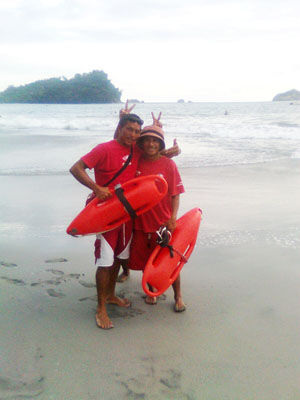 |
|---|
Two of Our Lifeguard Buddies (Also Called Salvavidas or Soccoristas) at Manuel Antonio Beach. Johnny ("Juancho") Left and Alvaro. Both live in GG's Neighborhood in Barrio Los Angeles in Quepos |
Nevertheless, we can get rip currents here that can carry even a strong swimmer out to sea and there have been several drownings over the years that prove how dangerous these currents can be. Many tourists don't recognize the distinct signs (more below) that a rip current is present and, when caught in one, don't know how to get out of the strong pull.
Having grown up on the North Shore of Massachusetts, our hero came equipped with the knowledge that swimming against the current can be futile, can contribute to panic setting in and quickly exhaust someone into a drowning situation.
The best reaction to being caught in a rip current is to swim perpendicular to the current (in this case, parallel to the beach) until you're out of the pull and then swim to the shore. Rarely are these currents more than 20 or 30 meters wide (25 to 35 yards).
We have lifeguards here that do a great job but municipality funding is limited and sometimes they are required to cover more beach than is best or they have to limit their hours of coverage, especially when the crowds hit during the high season (December to February). Several of the surf instructors are qualified in lifesaving and serve as backups to the regulars
The two dudes pictured to the left are stationed in the section of the beach where the ROMEOS and their friends perch to enjoy the scenic beauty, intercept food service vendors and render our dutiful service on bikini patrol. Don't let the pint size of these two guys fool you, both are coiled springs of about 97% muscle and could even haul a whale like GG out of the briny depths if necessary; hopefully, it won't be.
The beach here, despite being seemingly and completely flat, is actually a series of continuing, slightly wavy patches of sand of slightly differing heights. Rip currents are formed by the action of the waves hitting the beach and coming together between two of the elevated mounds of beach sand. Reinforcing each other, the combined backwash then slips off the beach going under the incoming waves until it surfaces beyond the wave break point. This sub-surface flow can continued for some time strengthening the outbound stream. A single rip current might continue outbound for a long distance, as much as half a kilometer. Eventually though, the countercurrents spread out and dissipate into the open sea.
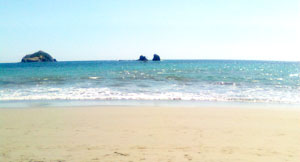 |
|---|
If You Look Closely You Can See the Beginnings of a Rip Current (Brown, in Front of the Twin Islands) Pushing Outward (Shoulda Got the Picture from A Parasail) |
If you're caught at the front end of one of these things you could easily end up 100 meters off shore swimming with the fishes. The good news is you can easily recognize a rip current before you plunge in. The action of the current sweeping under the inbound waves churns up the seabed of brown sand so the current is visible as a coffee-colored patch on an otherwise blue sea. In addition, the front end of the rip current is turbulent as it bucks against the incoming waves. When you see these signs and want to swim, it's best to be safe and go wide to the left or right of the patch to find the blue and relatively tranquil water.
If you're new here as a visitor or resident don't be dismayed. Most of the time the water here is friendly. I have several friends that routinely and safely swim the coast twenty to thirty meters off the beach.
The Pacific Ocean is beautiful but it can also be powerful and we need to respect that power for our own safety. When you hear the salvavida's whistle, check out where you're swimming and if they're blowing it at you and waving at you to go sideways, ignore them at your own peril.
As the t-shirt used to say: "Life's a Beach".
¡Pura Vida!
Life's a Beach
(Ceviche Anyone?)
When one is contemplating the development of a rip current, one should maintain decorum and a state of comfort, even in the sand. This is easy to do on our beach.
In most public beaches in the States direct sales people are prohibited from selling on the beach. In addition. there usually are strict regulations on "open containers (read beer) and, in some cases, like Sarasota, even smoking has been banned on the beach. The beaches here have not yet become that "sophisticated" so we continue to enjoy certain liberties and a variety of services.
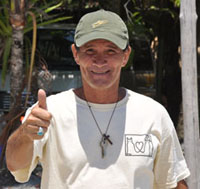 |
|---|
↑ Umbrella King Paluca and Colleague Harol (Harry)↓ |
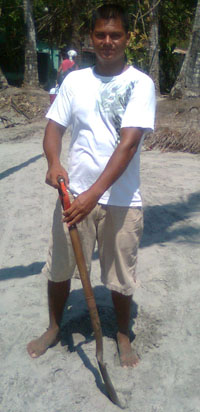 |
 |
Jaime Offers the Best Snowcone on the Beach |
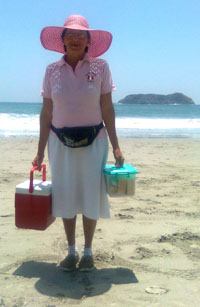 |
|---|
Senora Resplendent in Rose and Offering the Best Ceviche in the Area |
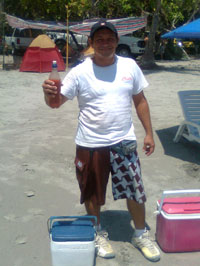 |
José - Best Empanada |
To get started, we need beach umbrellas and chairs. right? Well, I suppose we really don't need them but one hour under the sun here can turn you into a crispy critter, especially at this time of the year. Our buddy Paluca, who we've nominated to be Acalde de la Playa (Mayor of the Beach) along with his trusty assistant Harol (Harry) set us up with this important equipment.
Then, having been properly ensconced, we turn our attention to the food vendors. You never know which one will come by first or what will tickle your fancy on any given day.
Perhaps it would be best to start with a cup of ceviche. Our always-well-dressed lady ceviche vendor makes a great one. Fresh fish, shrimp or both are marinated in a mixture of Fresca (yes, that's right, soda) and mandarin lemon juice with chopped cilantro and thinly sliced red onions. It's served with a little hot sauce or ketchup mixed in. Dy - no - mite!
Or how about one of José's empanadas, a brown, crispy turnover stuffed with various combinations of chicken, shredded beef, potatoes, yucca, beans or cheese. While your seasoning your choice with a little sauce, José will perform his Tico Tom Cruise juggle act with the bottle while reciting a Spanish rap. José also happens to be the brother of "Juancho" mentioned in the article on Salvavidas above.
Or how about a snow cone? Our buddy Jaime will shave some fresh ice into a cup for you, sweeten it with one of a dozen or so syrups, add a scoop of powdered milk and a large dollop of condensed milk and create a sweet treat you won't soon forget.
If you're looking for more than fast food, there are also a number of servers that cruise the beach that are sent out by the local restaurants to take your order from their full food and bar menus. They will deliver it to your chair and include beer and soft drinks if you want.
There are a number of other purveyors that pass by including a couple of gents who will sell you a fresh coconut with the top lopped off with their machete so you can get to the healthful coconut water inside.
There are also a number of non-food vendors including some who sell a rather good quality of Nicaraguan pottery, a fellow who makes ornamental bugs out of aluminum wire and even a massage lady (you can get one on the beach most days).
And then there's our favorite vendor, a fellow named Geraldo who seems to have a corner on the beach towel market. Geraldo is 80 years old and plies the beach almost every day showing his collection of towels. ROMEO Brian often brings an extra bottle of water for Geraldo and the man can sometimes down the bottle in one continuous gulp.
So, you can see life at the beach is never dull and brings on a certain sense of responsibility that we ROMEOS must accept in order to provide proper management services to our beach. Somebody's gotta do it, amigos.
¡Solo Bueno!
Balls of Stone
(The Indians Had Them)
(Catchy header, eh? Makes you want to read on, amigo, doesn't it, just to see where I'm going?)
I'm not sure if it's because mankind has lived in a universe filled with billions of spheres that stimulates our fascination with them or it's simply because they're so common and easy to include in our rituals, like futbol, baseball and basketball but they do seem to accent our lives and they have done so since ancient times. Any day on the beach you will see youngsters from 3 years to 60 years kicking the old soccer ball around or slapping a winner across a volleyball net or simply two people tossing some kind of sphere to each other.
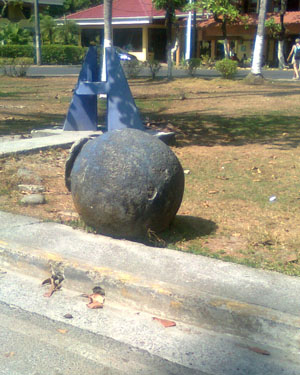 |
|---|
Dethroned Ball at Manuel Antonio Beach |
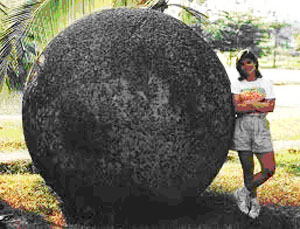 |
My Assistant (I wish) Shows How Big These Spheres Can Get |
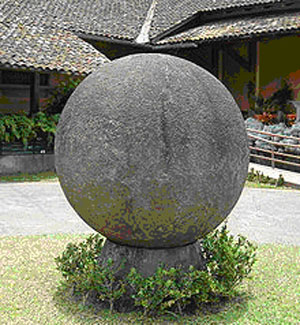 |
This One is Preserved in The Courtyard of the National Museum in San Jose |
One day, some five years ago on a visit here, our hero was walking near the last bus stop in Manuel Antonio down by the national park and I saw a round sphere some two feet in diameter sitting as if mounted for display. It was. Thinking it was a concrete casting, I approached it and found that instead it seemed to be made of solid stone or rock. It was. Since that time, the one at the beach appears to have fallen or been pushed off its mounting (see photo left).
There are a large number, reportedly more than 300, of these spheres in various places in protected and unprotected spots all over the Rich Coast. They range in size from a few centimeters (1-2 inches) to three meters (almost 7 feet). Most of the spheres are carved out of a rock called gabbro which is similar to basalt, a volcanic material. It's natural color is gray to black and it has a fine grain.
The spheres predominate along the Pacific Coast of Costa Rica, particularly in the Diquis Delta in the southwestern part of the country. The Diquis Delta is the valley in the OSA peninsula through which the Rio Grande de Térraba flows. For this reason the spheres are called "Diquis Spheres". Locals also call them Las Bollas or Las Bollas de Piedra (Balls of Stone).
Most archaeologists believe they were carved by the local natives (Indiginos) somewhere between 200 BC and 1500 AD. They are nearly perfect spheres and no one has yet come up with a technical explanation of how a relatively primitive culture could carve stone with such circular precision.
One scientist has suggested that the carving of the stones could have been measured against a large wooden "template" or semi-circle and further refined by stone abrasion until the sphere was nearly perfect. We may never know exactly how they were made as the practice of carving the stones died out with the onset of the Spanish in the 1500's, making the stones "pre-Columbian". The Spanish invasion caused the disruption and destruction of the local culture and the stones disappeared.
The stones were first re-discovered by the United Fruit Company in the 1930's when as they plowed land to plant their first banana plantations. (For more on how and where the United Fruit Company came about, see Choo Choo Chiquita) The heavy equipment used by the workmen damaged some of the spheres and others were broken open by those who believed in a legend that gold might be in the center of the ball. It wasn't.
It took, however, the daughter of one of the United Fruit executives to recognize the potential archeological significance and start the ball rolling towards preservation by bringing in archaeologists and other scientists to investigate them.
Just why the natives carved and used these stones also remains a mystery. They were found in a variety of locations both social and ceremonial. Some locations have yielded pottery shards that indicate some practices were held near the spheres, perhaps religious. A few of the stones have been found in small formations similar to the alignment of some celestial bodies. The fact that the stones were moveable and did undergo relocation has confused the issue somewhat as to what they were used for
So, if you come across one of these curious beauties, be sure to treat it with the respect it deserves. And remember, "Rolling Stones gather no moss (how did those dudes get into the picture?)".
What's-in-a-Word
Golden Gringo
I originally took this name as a way of expressing that I'm a lucky gringo. You know, like I'm coming up golden. This is, however, another case of how an American colloquialism doesn't translate well.
Sometime later I found that the term "Gringo de Oro" might be construed as being a rich gringo by locals, so I started signing the chronicles as El Gringo Dorado, which I thought sounded more like a gilded one rather than a rich one, the latter being obviously untrue. When I changed the name, I didn't think there could be a further interpretation of this moniker. Wrong again, tarnished one.
 |
|---|
The "Golden Gringo" Mutt |
Now a friend of mine from Florida (and even before that as we roomed together in Pennsylvania in the 90's) has come up with another variation. Of course there's a certain poetic or writer's justice in this because he got the info by Googling "Golden Gringo" right after I wrote the article on Giggle, Gaggle, Google last month.
Soooo, a Golden Gringo also turns out to be a breed of Doberman as shown to the left. The one pictured is actually a Golden Gringo of Tanderburg.. I'm not sure what or where Tanderburg is but it seems (per Google, of course) that it's an old family name, like Baskerville (and maybe the hounds thereof).
Actually, I don't mind being compared to such a good looking mutt but I am a bit jealous of how sleek and in good shape he is, not to speak of his shiny coat.
If you Google Golden Gringo Chronicles instead of just Golden Gringo, you immediately get the GGC Archives page. So much for the "private" website idea - those Google spiders that crawl the net can find anything.
 |
|---|
GGC - Home of the Mighty " Gwinnitt Grizzlies" |
But if you Google "GGC", a whole bunch of stuff pops up. (1) Greenwood Genetic Center, working on birth defects (my mom might have used you 68 years ago); (2) Georgia Gulf Corporation, a $3 Billion manufacturer of vinyl chemicals and polymers, (3) Gotland Game Conference at Gotland University in Visby, Sweden (holy criminee, Olaf). And then there's Georgia Gwinnitt College.
The strangest reference that came up was labeled "Global Gifting Connection". The references for this are in Spanish and my poor translation says they're involved with some kind of distribution or re-distribution of some kind of mysterious wealth (maybe it's a front for Acorn International, I dunno).
Whatever, but with regard to Golden Gringo, it's too late to change my signature now amigos; and Google would expose any new duplications, canine or otherwise.
Woof..
ROMEO Corner
(Retired Old Men Eating Out)
Miguelito's - Quepos
Location: Downtown Quepos on the North Side of the Central Wood Pile and Next to Musmanni;
Take-Out and Delivery Service Available
Hours: Sunday thru Thursday 11 AM to 10 PM; Friday-Saturday 11 - 11.
Parking: Limited to Street Parking but Usually Not a Problem in the Evening
Contact: Tel: 2777-4236
Reviewing ROMEOS: Brian M., Alice Lee, Bob N.
Everybody needs at least one good pizza place (we now have several options in the area) where they can go for good mental health, especially when casados start to get a little old. Miguelito's serves that purpose well for anyone living in the Quepos/Manuel Antonio area.
Miguelito's has been a landmark in Quepos for years but recently changed ownership. The new owner-chef Todd Godfrey is a gringo with many years experience at CiCi's, Pizza Hut and other pie emporiums and really knows how to put a pizza together. The formula for the store that Todd has employed is simple and to the point and allows his staff to concentrate on the basics. The offering consists simply of pizza, calzones and wings. The dining room is simple as a pizza place should be and offers a choice of tables or booths. The lighting is bright making the place cheery. The walls are covered with paper pie plates resplendent with hand drawings by kids, which gives the place a very family atmosphere. This was a practice started by the previous manager, continues with Todd and is popular with tico families. |
 |
|---|---|
$$$ |
The ROMEO team gives high marks to the restaurant for consistent food quality and taste. Evidently many others do too as the place is popular with both gringos and ticos and routinely is quite busy - Todd appears to have figured out the formula that appeals to both nodes of our bicultural market here. The pizza ingredients are fresh, the crust is crisp and the toppings are generous. The wings are also very good and quite large in proportion. The calzones are the same as the pizza, fresh and served hot in a great, crispy crust with added sauce to soak them down. Prices are moderate for the Quepos/Manuel Antonio area.
We give Miguelito's four sloths for atmosphere, food quality and service and three dollars for cost. In our book that's a great value. Whether you're taking the kids out for a special family treat or just escaping the need to cook tonight or just gotta have a slice, Miguelito's is a good and reliable option for you.
Location: La Sabana West, Across the Street from National Stadium
Hours: 11:00 AM to 10:30 PM Monday thru Sunday
Parking: Considerable in front of and to the side of the restaurant but this place looks like it’s so
busy that sometimes parking can be tight. There are parking attendants to help (I think they're legit but Caveat Emptor is always a good practice in San José)
Contact: Teléfono: (506) 22 96 76 67; Fax: 22 96 37 39.
More Info: http://www.princesamarina.com/rests.html
Reviewing ROMEOS: Bob N. (12 Jan 2012)
This is a Tico landmark, primarily offering seafood and therefore is entitled to call itself a “Marisquería”. It turns out there are four of these restaurants in the greater San José area. In addition to this one near the Sabana Park and National Stadium, there are others in Curridabat, Alejuela and Moravia.
I was immediately struck by the busy atmosphere of the place. There appears to be seating for over 100 and it was better than half filled at 6 PM when I arrived, an early dinner hour for Ticos and the vast majority of those already eating were Ticos. Waiters in simple black pants and white shirts were busy bustling arm loads of food to tables.
I was recognized by a waiter very quickly with a menu. I saw an older gentleman (that means my age) walking around the cash register supervising everything and immediately assumed him to be the “patroni”. I also noticed my waiter bore a younger resemblance to the patroni and judged him to be the son. I asked the waiter to confirm both assumptions which he did. He told me the restaurant has been in business for 24 years. Suddenly I felt very comfortable as the signs were good; the place is a family business, the family works there and it's frequented by the local populace.
The decor is simple and functional. No velvet drapes and candles here, just simple wood-topped tables, basic chairs and ample lighting. The whole place comes across more like a brasserie than a seafood restaurant. Although a little less fancy, it reminded me of the Oyster Bar at Grand Central Station in New York City (The Oyster Bar is still there amigos, I saw it on Fox news; be sure to go there if you’re in New York).
For first course I chose a shrimp based creamed soup that was flavored with a micro chop of onions and celery (I have always admired the way Ticos can dice stuff into 2 millimeter squares) as well as the obligatory cilantro; it was very tasty. For a main course I selected a “mariscada” which they interpreted on the menu to be a “shower” of seafood but which we would probably call a seafood platter in most stateside regions. Of the several ways offered to prepare the dish I chose sauteing in garlic butter. I received a large mound of very tasty pieces of calamari, shrimp, fish, small clams and a few mussels with a dollop of mashed potatoes and a garnish as well as a small side salad with a dribbling of dressing similar to Russian. |
 |
|---|---|
$$$ |
For desert I chose Tres Leches, that classic Tico cake saturated with three kinds of milk (evaporated, condensed and whipping cream). Again, fresh and tasty. The waiter continued to be friendly, helpful and efficient throughout the meal. I give La Princesa Marina four sloths for atmosphere, food and service.
The bill came to 10,500 colones or $21 for the three courses with only a coke for drink. That seems like a bargain for excellent seafood, so I give the place a modest three dollar rating.
Four sloths and three $ make for a high value in my book. La Princesa Marina is very seafood, very Tico and very good.
Founder's Quotes
James Madison on how to handle the national debt"
"There is not a more important and fundamental principle in legislation, than that the ways and means ought always to face the public engagements; that our appropriations should ever go hand in hand with our promises. To say that the United States should be answerable for twenty-five millions of dollars without knowing whether the ways and means can be provided, and without knowing whether those who are to succeed us will think with us on the subject, would be rash and unjustifiable." --James Madison, Speech in Congress, 1790
Twenty-five millions eh; how about 25 Trillions or 25 million millions, Jimmy.
don Beto de Quepos, El Gringo Dorado Pura Vida! |
Be pithy but kind. I'm sensitive. |
|---|

